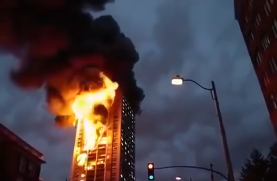
A catastrophic 7.7-magnitude earthquake struck without warning near the China–Myanmar border early this morning, leaving destruction across multiple countries and plunging millions into chaos. Within minutes, peaceful mountain towns became fields of rubble, roads split open like paper, and terrified families fled into the darkness with nothing but the clothes on their backs.
The quake, described by seismologists as “shallow and violent,” hit just after dawn, with its epicenter located less than 10 kilometers beneath the surface — shallow enough to unleash massive damage across the region. The U.S. Geological Survey confirmed the tremor’s location near the border between Yunnan Province, China, and northern Myanmar, an area notorious for seismic instability.
In towns closest to the epicenter, the shaking was so intense that entire buildings crumbled in seconds. Satellite images later revealed entire neighborhoods reduced to dust. Concrete walls collapsed like sand, roads twisted into jagged scars, and bridges simply vanished. The first aftershocks struck within minutes — powerful enough to bring down what little was still standing.
Across Yunnan and Shan State, panic spread as power grids failed and communication networks went down. Survivors scrambled into the streets barefoot, clutching children and elderly relatives, searching desperately for open ground. Witnesses reported waves of tremors so strong that cars bounced off the pavement and glass exploded outward from windows.
In Chiang Rai and Chiang Mai, Thailand, hundreds of miles from the epicenter, residents woke to walls trembling and chandeliers swaying. “It felt like the ground was breathing,” one witness said. “We ran outside, but the shaking kept coming — long and deep. It wouldn’t stop.”
As dawn broke, the true scale of the catastrophe began to unfold. In Myanmar’s border town of Lashio, where many buildings are older and made of brick, entire blocks were leveled. Dozens of people were confirmed dead within hours, and local hospitals — some of which were damaged themselves — overflowed with the injured. Doctors treated patients in parking lots using flashlights and battery-powered lamps.
In China’s Tengchong County, rescue teams battled to reach trapped residents through collapsed streets. Reports described families calling for help from beneath concrete slabs, their voices faint but desperate. In one viral video circulating on Chinese social media, a man could be seen digging with his bare hands to free a trapped child as others shouted for tools and flashlights.
Authorities across all three countries immediately mobilized emergency response units. In China, more than 5,000 personnel — including military engineers and firefighters — were dispatched to the region. In Myanmar, local rescue teams struggled through landslides and damaged roads, trying to reach mountain villages cut off entirely from the outside world. Helicopters dropped water and medical supplies to areas inaccessible by land.
Still, the task remains overwhelming.
“We’re fighting time and terrain,” said Li Wenhao, a Chinese emergency coordinator. “The aftershocks are constant, the roads are blocked, and communication lines are unstable. Every minute counts.”
By mid-morning, humanitarian agencies had joined local efforts. The Red Cross released an urgent appeal for international assistance, warning that thousands were likely injured or displaced. Temporary shelters were being set up in schools, stadiums, and open fields as frightened residents refused to reenter damaged buildings.
In the city of Baoshan, where hundreds of structures have been declared unsafe, survivors huddled under makeshift tents, clutching blankets and bottled water distributed by volunteers. The smell of dust and gas leaks filled the air. “It’s like the world broke in half,” one woman told reporters, holding her young son. “One moment we were eating breakfast. The next, everything fell.”
Satellite data analyzed by the European Space Agency showed significant ground deformation stretching across the China–Myanmar border region — a clear indication of massive tectonic slippage. Geologists warn that such displacement could trigger further seismic activity in the days ahead, particularly along the Sagaing Fault and the Red River Fault, two of Southeast Asia’s most active fault systems.
“This region has always been fragile,” said Dr. Amara Thipchai, a geophysicist based in Bangkok. “The energy released today was enormous, but stress could easily transfer to adjacent fault lines. We’re likely to see more aftershocks — possibly severe ones — in the coming days.”
International reaction was swift. The United Nations expressed condolences and offered emergency aid, while neighboring countries prepared to send rescue teams and supplies. China’s Ministry of Emergency Management called the disaster “one of the most serious seismic events of the decade” and ordered the immediate deployment of heavy-lift helicopters, drones, and portable hospitals.
In Myanmar, state media confirmed widespread damage in towns across Shan and Kachin states. Videos showed pagodas collapsed into piles of brick, power poles snapped like twigs, and markets destroyed. Many survivors have resorted to cooking over open fires and drawing water from wells, uncertain when help will arrive.
As night fell, the challenges deepened. Rescue workers, wearing headlamps and breathing through masks to block the dust, continued to search the ruins for any sign of life. In several locations, faint tapping was heard beneath debris, sparking frantic efforts to dig through the rubble. “We don’t know how many are still trapped,” one rescuer said, “but we won’t stop.”
In southern China, hospitals began setting up outdoor triage centers to handle the influx of injured patients. Rows of stretchers filled courtyards, while volunteers passed out bottled water and blankets. A doctor from Kunming described scenes of exhaustion and heartbreak: “We’ve seen crushed limbs, head injuries, burns. Many patients don’t even have shoes — they ran barefoot when the shaking started.”
The quake’s ripple effects reached as far as Bangkok and Dhaka, where residents reported mild tremors. While damage there was minimal, the psychological impact stretched far beyond the quake zone. Social media feeds across Asia were flooded with messages of support, pleas for information, and videos of the destruction.
By evening, officials confirmed that aftershocks exceeding magnitude 5.0 had already struck at least six times, further hindering rescue efforts. Seismologists caution that these may continue for weeks.
Relief convoys are now en route from neighboring provinces, carrying tents, fuel, and emergency rations. Still, the scale of the disaster is daunting. Entire communities remain unreachable, power is down across vast stretches of rural terrain, and hospitals are running low on blood and medical supplies.
For now, as rescue teams dig through twisted metal and concrete by flashlight, one truth dominates the region: nature’s power remains far beyond human control. What began as an ordinary morning has become a test of endurance, compassion, and survival for millions.
As one exhausted volunteer put it late tonight, standing in the ruins of his hometown: “We can rebuild walls. But we can’t bring back the people we’ve lost.”
And with that, the world watches — holding its breath, hoping that when dawn rises again over the mountains of China and Myanmar, there will still be voices left to answer.



